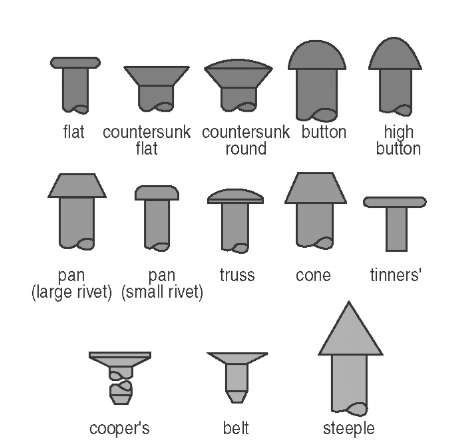Rivet connections are particularly suited to structures that face dynamic and cyclic loading, as they provide excellent fatigue resistance.

Rivet connections have been central to steel construction for over a century. Riveting was the standard method for joining steel components before the development of welding and high-strength bolts. Early skyscrapers, bridges, and industrial facilities all relied on rivet connections due to their durability and predictable load-carrying performance. Unlike bolts, which can be loosened or replaced, rivets create a permanent bond that, when properly installed, remains effective for the structure’s lifespan.
In rivet connections, each rivet functions by deforming plastically to fill its drilled hole. This process forms a tight connection that resists various forces, including shear, bearing, and in some cases, tensile loads. Rivets distribute load across their entire surface area, effectively minimizing stress concentration and preventing cracks and fractures in the surrounding material. While modern structures rely less on rivets, their lasting presence in steel design highlights their unique advantages, especially in structural applications where stability, reliability, and load distribution are critical.
Rivet connections suit structures that face dynamic and cyclic loading particularly well, as they provide excellent fatigue resistance. Due to their effectiveness in dissipating forces, rivet connections are also specified in situations where the structure is subject to vibrations, repeated loading, or harsh environmental conditions. These advantages make rivets a viable choice for both structural applications and preservation projects.
Types of Rivets and Their Applications
There are several types of rivets, each chosen based on the connection’s requirements and the properties needed for a specific structure (Figure 1). Let’s examine the main types of rivets commonly used in steel construction:

Button Head Rivets
Button head rivets, recognized by their rounded heads, are a traditional choice in structural steel connections. They are robust and provide a clean finish but protrude slightly from the material surface. Industrial applications commonly use button head rivets where structural performance takes priority over aesthetics..
Their rounded heads are suitable for applications that need resilience against wear, especially if exposed to outdoor or abrasive conditions.
Countersunk Rivets
Designers use countersunk rivets to sit flush with the material’s surface, making them ideal for applications that require smooth surfaces. This type works particularly well in aerodynamic structures, such as bridges or vehicles, where minimizing surface drag is essential.
Countersunk rivets are also chosen for architectural projects where aesthetic appeal and a seamless finish are desired. They are effective in providing a strong connection without impacting the structure’s visual appearance.
Snap Head Rivets
Snap head rivets resemble button head rivets but with a larger, more pronounced head shape. Projects that require both strength and appearance frequently use these rivets. Engineers often employ snap head rivets in bridge construction and other high-load applications because their large head provides a greater load-bearing surface, enhancing stability. Their shape allows for even stress distribution, which is particularly beneficial in high-stress areas.
Semi-tubular Rivets
Semi-tubular rivets, also known as hollow rivets, feature a partially hollowed shank. This hollow section reduces the force required for installation, making them a practical choice for applications that demand a high number of rivets. Light-duty applications commonly use semi-tubular rivets, though they are less prevalent in heavy structural steel.
They offer benefits in manufacturing processes that involve repetitive installation and can be used in secondary steel elements or for connecting lighter materials where excessive load is not a concern.
Bifurcated Rivets
Bifurcated rivets have a split shank that spreads upon installation, forming a secure bond with the connected materials. This type is advantageous in projects that require fast and efficient installation, often for non-load-bearing elements or where temporary connections may be needed.
Bifurcated rivets are less common in structural steel but can be beneficial in secondary elements or in fixtures that require quick assembly without specialized tools.
Key Design Considerations for Rivet Connections
When designing rivet connections, engineers must account for multiple factors to ensure a safe, reliable joint. Key design considerations include:
Shear and Bearing Strength
Rivet connections primarily resist shear and bearing forces. Shear strength refers to the rivet’s ability to withstand forces that cause sliding between connected plates. Bearing strength, on the other hand, pertains to the rivet’s capacity to resist crushing within the connected material. Ensuring adequate shear and bearing strength helps prevent failure under high loads.
Rivet Spacing and Edge Distance:
Proper spacing between rivets is crucial to prevent stress concentration. Excessive proximity can lead to material tearing or cracking, especially under cyclic loading conditions. Designing requires must maintaining adequate edge distances from the rivet to the edge of the connected plates. Proper edge distance prevents the rivet from exerting excessive stress on the material’s edge, which could lead to failure over time.
Load Path and Distribution
Rivet connections should be designed to ensure an even load distribution across all rivets in the connection. In multi-rivet configurations, this approach prevents a single rivet from carrying more load than others, minimizing the risk of localized failures. For complex load paths, careful analysis is required to determine how forces distribute across rivets and connected elements.
Material Compatibility
Rivets must be compatible with the materials they are joining. Steel structures often use steel rivets to ensure a consistent response to thermal changes and loads. In applications with dissimilar metals, designers must consider the potential for galvanic corrosion. Using compatible materials or adding insulating layers can prevent such issues.
Worked Example
Design a rivet connection to join two steel plates, each with a thickness of 8 mm, using 12 mm diameter rivets to resist a shear force of 150 kN. The rivets and plates are made of steel with a yield strength of 355 MPa and an ultimate tensile strength of 410 MPa. The design should follow standard guidelines for calculating shear capacity, bearing capacity, and determining the required number of rivets, spacing, and edge distance, with a partial safety factor for materials set at 1.0.
Step 1: Calculate Shear Capacity per Rivet
Calculate the shear capacity, VRd, per rivet:
P_v=\frac{f_u\times A_r}{\gamma_M}where:
- fu=410 MPa (ultimate tensile strength of steel),
- Ar is the cross-sectional area of the rivet,
- γM=1.0.
Calculating Ar
A_r=\frac{\pi d^2}{4} =\frac{\pi 12^2}{4} =113mm^2Then,
P_v=\frac{410\times113}{1.0}=46.37kNEach rivet can carry a shear force of 46.37 kN
Step 2: Determine the Bearing Capacity of a Rivet
The bearing capacity of a rivet depends on the rivet diameter, plate thickness, and ultimate tensile strength of the plate. It is given by:
P_b=\frac{2.5\times d\times t \times f_u}{\gamma_M}=\frac{2.5\times12\times8\times410}{1.0} =98.4kNEach rivet can carry a bearing load of 98.4 kN
Step 3: Calculate the Required Number of Rivets
Since each rivet must resist the applied shear force of 60 kN, we calculate the number of rivets required by dividing the total shear force by the lesser of the shear and bearing capacities (since the connection is governed by the lower capacity).
n=\frac{F}{min(P_v,P_b)} =\frac{150}{46.37}=3.23Rounding up, we need 4 rivets.
Step 4: Determine Rivet Spacing and Edge Distance
Rivet Spacing
The minimum rivet spacing (center-to-center distance between rivets) should generally follow these guidelines:
s =2.5d=2.5\times12=30mm
The minimum edge distance from the center of a rivet to the edge of the plate is typically:
s =2.5d=1.5\times12=18mm
So, the edge distance should be at least 18 mm.
Design Resume
- Number of Rivets Required: 2 rivets
- Rivet Spacing: Minimum 30 mm
- Edge Distance: Minimum 18 mm
See: Design of Bolted Connections | Worked Example
Sources & Citations
- Structural Steel Design: A Practice-Oriented Approach by A. K. Khurana, 2018.
- Eurocode 3: Design of Steel Structures – Part 1-8: Design of Joints (EN 1993-1-8). European Committee for Standardization (CEN), 2005.
- Design of Steel Structures: Eurocode 3 by W. T. Grondzik, 2009.
- Design of Structural Steelwork: Eurocode 3 by G. S. R. J. Williams, 2012.